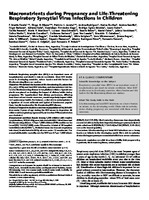Repositorio Digital
Macronutrients during pregnancy and life-threatening respiratory syncytial virus infections in children
- DSpace Principal
- →
- Hospital El Cruce
- →
- Publicaciones
- →
- Artículos
- →
- Ver ítem
JavaScript is disabled for your browser. Some features of this site may not work without it.
Macronutrients during pregnancy and life-threatening respiratory syncytial virus infections in children
Ferolla, M; Hijano, D; Acosta, P; Rodríguez, A; Dueñas, K; Sancilio, Andrea; Barboza, E; Caría, A; Gago, G; Almeida, R; Castro, L; Pozzolo, C; Martínez, M; Grimaldi, L; Rebec, Beatriz; Calvo, M; Henrichsen, J; Nocito, C; González, M; Barbero, Guillermo; Ves Losada, Juan; Caballero, M; Zurankovas, V; Raggio, M; Schavlovsky, G; Kobylarz, A; Wimmenauer, V; Bugna, J; Williams, J; Sastre, G; Flamenco, E; Pérez, A; Ferrero, F; Libster, R; Grijalva, C; Polack, F
URI:
http://hdl.handle.net/123456789/215
http://www.atsjournals.org/doi/abs/10.1164/rccm.201301-0016OC
http://www.atsjournals.org/doi/abs/10.1164/rccm.201301-0016OC
Fecha:
2013
Resumen:
Rationale: Respiratory syncytial virus (RSV) is an important cause of hospitalization and death in infants worldwide. Most RSV deaths occur in developing countries, where burden and risk factors for life-threatening illness are unclear.
Objectives: We defined the burden of life-threatening (O2 saturation [O2 sat] ≤ 87%) and fatal RSV infection, and characterized risk factors for life-threatening disease in hospitalized children. Special emphasis was placed on studying the impact of dietary habits during pregnancy. We hypothesized that dietary preferences, differing from those of our remote ancestors, would negatively impact children’s pulmonary health. For instance, a diet rich in carbohydrates is a signature of recent millennia and typical of low-income populations, heavily burdened by life-threatening RSV disease.
Methods: Prospective study in a catchment population of 56,560 children under 2 years of age during the RSV season in Argentina. All children with respiratory signs and O2 sat less than 93% on admission were included.
Measurements and Main Results: Among 1,293 children with respiratory infections, 797(61.6%) were infected with RSV: 106 of these had life-threatening disease; 1.9 per 1,000 children (95% confidence interval [CI], 1.5–2.2/1,000) under 24 months. A total of 22 hospitalized children died (9 RSV+), 26 died at home due to acute respiratory infection (14 attributed to RSV); all were under 12 months old. The annual attributable mortality rate for RSV was 0.7 per 1,000 infants (95% CI, 0.4–1.1/1,000). Life-threatening disease was dose-dependently associated with carbohydrate ingestion during pregnancy (adjusted odds ratio from 3.29 [95% CI, 1.15–9.44] to 7.36 [95% CI, 2.41–22.5] versus the lowest quartile).
Conclusions: Life-threatening and fatal RSV infections are a heavy burden on infants in the developing world. Diets rich in carbohydrates during pregnancy are associated with these severe outcomes
Descripción:
Ficheros en el ítem
Este ítem aparece en la(s) siguiente(s) colección(ones)
-
Artículos
Articles
Buscar
Listar
-
Todo DSpace
-
Esta colección

